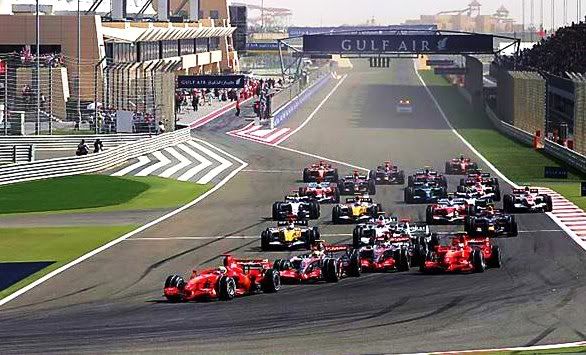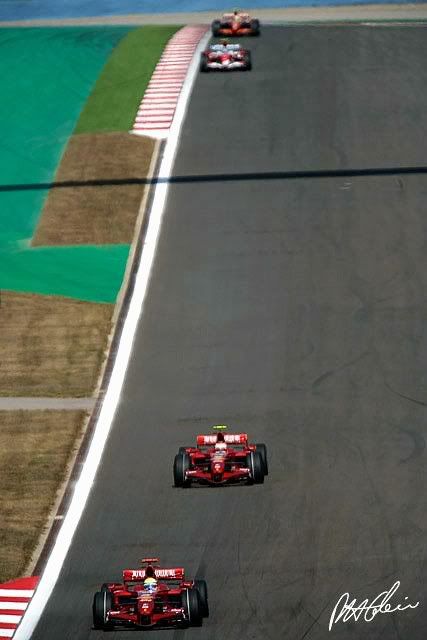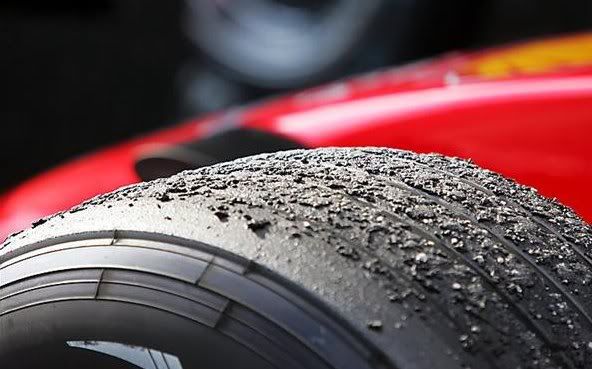August 28, 2007
Many F1 tracks are used pretty much only for the Grand Prix they were designed for. The Istanbul Autodrom (according to the Legendary Announce Team), in fact, is used just once a year. As a result, these courses get... well, dirty.
Like the dust in the corners of The Pond, detritus will build up on the course. This ranges from dust, to rain residue, to salt (Sepang), to sand (Bahrain). This is magnified if the track isn't used often. Some places, such as Silverstone in England, are used so often that this isn't usually a problem.
Okay, so the track is dirty. Just a little dust, right? Well, not exactly... Steve Matchett, gearhead member of the LAT, jokes that F1 tires run best on F1 tire rubber. This is actually true of ALL high-performance racing tires, and is one of the reasons why, for example, drag racers perform burnouts before they stage for their races: not only are they heating up their tires, but they're laying down rubber so the tires can grip better.
But what does that have to do with a dirty track?

A lot, actually. In the picture above, I've fiddled with the contrast and color so as to make the 'racing line' obvious, and thereby point out the difference between the Clean side and the Dirty side. The dark portion of the track is made so by a weekend's worth of laps being turned on soft rubber tires (note: even the hardest, longest-lasting F1, IRL or ChampCar racing tires would be turned to dust after a few miles on your average city streets. NASCAR tires are somewhat more durable).
The first cars on the track in the Friday practice sessions are often called "sweepers". These cars, usually the bottom-feeder teams (like Spyker) that need a lot of practice to get their cars set up, do two things on their first few laps. One, they begin the process of laying down rubber on the racing line, and two, they blow the racing line clear of dust/sand/marmots/whatever... "sweeping" the track clean.
But they're not cleaning the whole track, just the path they're taking around the course. That's the racing line, the fastest way through the turns. "But that's the turns," you say, "what about the straightaways and the starting grid?"

Well, remember what I said about F1 tires running best on F1 tire rubber? All F1 drivers will follow the same path around the course, even on the main straightaways. This is because 1) that's where some rubber has been put down and 2) that's where the dust isn't. Even in the picture above, you can see that the portion of the track to driver's right (where the cars are) has a lighter shade than to driver's left. That's from the cars going over the same bit of road, over and over and over again.
THAT'S the clean side of the track.
When the cars come to the starting grid after the formation lap, you'll see them form up in a single-file line, then peel off when they come to their grid position. That's because the drivers want to spend as little time as possible off the clean side of the grid.
Y'see, F1 tires work best when they're hot. The rubber starts to get softer (and stickier) as they get hot. You can say that the tires are nearing the verge of melting, and you wouldn't be too far wrong. As the rubber heats up and becomes stickier, it picks up anything it runs over, and even something as small as dust will affect the grip of the tire.

F1 drivers are usually told to "pick up rubber" on the victory lap. This adds weight to the car, and therefore makes it that much more likely that the car will pass the mandatory FIA weigh-in after the race. The rubber it picks up is found off the racing line, basically on the dirty side of the track.
To answer Vauc's question about 'marbles', that picture above gives you an example of what marbles are. Essentially, pieces of rubber that are shed by tires during the course of the race end up off-line, generally on the outside of a turn. Since they're lying loose on the track, driving on them at race speeds is a very dicey proposition, as they completely destroy grip... as if you were driving on marbles.

A whole weekend's worth of sweeping and laying rubber can be ruined by a 30-minute downpour, however. It doesn't take much to wash the rubber put on the racing line away... it's not bonded with the track surface, but just put on top of it. Think of your city streets; often you may see a skid mark at an intersection from someone who had to panic-stop. Over the next day or three, it'll disappear. That's because the rubber is worn away, or washed off. Same thing happens at a F1 track.
So, that's the basic story behind Clean vs Dirty. Have any questions? Let me know in the comments!
Posted by: Wonderduck at
07:02 PM
| Comments (7)
| Add Comment
Post contains 898 words, total size 6 kb.
Posted by: madmike at August 29, 2007 06:04 AM (o+iiH)
Posted by: Will at August 29, 2007 06:17 AM (SOx9v)
Posted by: Steven Den Beste at August 29, 2007 07:09 AM (+rSRq)
Posted by: Mallory at August 29, 2007 11:09 AM (h9L6l)
Because the tracks are so wide in places, you may have 3 or 4 trucks driving in echelon to get everything off the track.
Doing the same would be a bit more tricky with the winding tracks of F1, but still do-able.
Posted by: Will at August 29, 2007 11:56 AM (SOx9v)
Posted by: Wonderduck at August 29, 2007 03:34 PM (M7kiy)
Posted by: madmike at August 30, 2007 04:03 AM (o+iiH)
47 queries taking 0.489 seconds, 283 records returned.
Powered by Minx 1.1.6c-pink.









